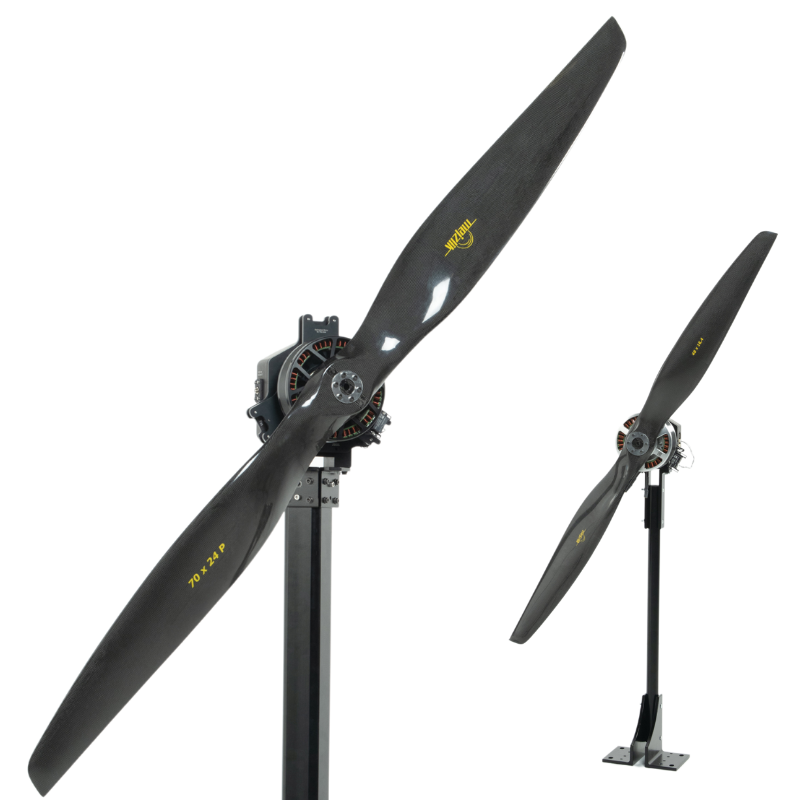When it comes to data measurement, there is an important difference between static and dynamic testing.
In this article we will cover the definitions of both, plus their pros/cons.
In our lab we manufacture static AND dynamic propulsion test stands and software, which measure the performance of brushless motors and propellers.
Table of Contents:
- What is Static and Dynamic Testing (definition)
- Static vs. Dynamic Testing Comparison (infographic)
- Applications for Static and Dynamic Testing
- How Our Tools Handle Dynamic Tests

1. What is Static and Dynamic Testing?
Dynamic testing AKA real-time testing describes a test where the dynamics of the measured system are important. The timestamps associated with the measured values have to exactly match the timestamps at which the analog measurements are taken on the circuit board.
In order for dynamic testing to be accurate and effective, it is essential that the timestamps are synchronized across all connected hardware, ensuring that all devices are operating under the same clock.
To achieve accurate results, dynamic testing requires a minimum sampling rate that is twice the frequency of the signal being measured. This is known as the Nyquist frequency, and it is the minimum sampling rate necessary to avoid aliasing and ensure that the signal being measured is accurately represented.
Static testing is a test in which the measured values are constant or changing slowly.
There are fewer requirements when doing static testing: the measurement synchronization is not as demanding, filters with higher time constants can be used, and the sampling rate can be lower.
2. Static vs. Dynamic Testing Comparison:
This infographic shows the different types of tests across a range of sampling frequencies. The left side shows the static tests (1 - 10 Hz), and the right side shows the different kinds of dynamic tests (50 - 90,000 Hz).

3. Applications for Static and Dynamic Testing
When it comes to data measurement and testing, there are uses for both static and dynamic testing.
Static testing is often sufficient for characterizing electric propulsion systems when a general understanding of the system is sufficient.
With static testing you gain a good understanding of the efficiency of your system at multiple levels (motor, propeller, overall), and you can make accurate predictions about in-flight performance.
Dynamic testing is important in four main cases:
- Characterizing the dynamic response of the motor and propeller for simulation.
- Highly competitive industries where even small performance improvements can give you an edge.
- Applications where safety is a primary concern and precisely characterizing a system’s limits is vital.
- Research and development projects where you need a deeper understanding of the elements of your system, such as propeller vibration profiles and precise current and voltage curves.
When it comes to data measurement, whether you should choose static or dynamic testing really depends on your needs and application.
4. How Our Tools Handle Dynamic Tests
There are many applications for our propulsion testing tools, some that are served by static testing, and others that require dynamic testing.
Both of our measurement systems (static and dynamic) include a force measurement unit, an electrical measurement unit, and a sync hub that is connected to the computer and software via USB.
There are a few key differences in how static and dynamic tests are handled by this system.
To ensure that dynamic testing is possible, we started by designing our ‘Pro’ stands with a sampling rate of 1,000 Hz.
This sampling rate has to be supported by the force measurement unit (figure 3), electrical measurement unit, sync hub, and software.

In order to ensure all four components are properly synchronized, we designed a special algorithm and synchronization hardware to keep it all running under the same clock.
This in turn prevents USB latency and IO processing delays that could cause timing errors.
Conclusion
In conclusion, static and dynamic testing both play a role in data measurement.
The method you choose depends on your application and data needs.
If you are looking for a static or dynamic test stand for characterizing your electric motors and propellers, check out our Flight Stand 15/50.



 Back to Blog
Back to Blog


Leave a comment